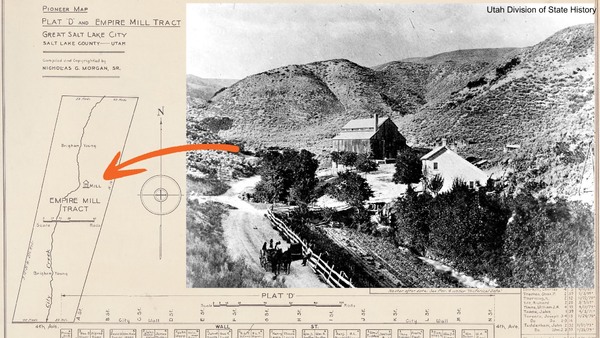Dublin Core
Title
Description
In the upper reaches of Memory Grove, along City Creek on the edge of downtown Salt Lake City, dog walkers and hikers often stumble across the ruins of the old “Witch’s Cabin.” Ghost stories about the ruins include disembodied lights and voices. Sometimes there is a bride, sometimes a witch, and sometimes a witch that turns into a tree. In reality, these stone ruins are the remnants of a home and nearby grist mill that used the running waters of City Creek to process wheat.
Called the Empire Mill, the original structure was built in 1862 by architect Frederick Kesler for Brigham Young. It processed grain donated by LDS Church members as part of their tithing, and the resulting flour was sold to raise funds for the Church. The mill was three stories tall with a stone foundation and wood frame superstructure. A massive 30 ft diameter waterwheel powered the machinery using the flow of City Creek. It produced 100 sacks of flour a day with its two pairs of grinding stones. Next to the mill was a house, garden, and orchard belonging to the Sudbury family who ran the mill. On May 22, 1883, the mill burned to the ground, destroying $8,000 worth of wheat and flour -- that’s about $235,000 today. After the fire, the city of Salt Lake purchased part of City Creek Canyon from the Young family in 1902, including the ruins of the Empire Mill and Sudbury House, and built a bandstand on the foundation in 1914 as part of the grand opening of the new City Creek Boulevard.
Today, the area is a dog park and bike trail. The ruins are imagined as the home of spooks and witches, but once upon a time the Sudbury house, Empire mill, and adjacent City Creek played a critically important role in the early Mormon economy. Throughout the 1920s, the ruins became known as Sudbury’s Flat, a popular spot for picnics. But by the 1970s, memory of the mill and house were mostly forgotten. For better or for worse, the urban legends of hauntings became more prevalent, and the rich history of how City Creek’s water helped feed the early Mormon settlers, was lost.Creator
Source
_______________
See Rachel Quist, “The Witch's House in City Creek Canyon... Is Really the Empire Mill,” 23 October 2021, Rachel’s SLC History, accessed October 2022; “The Empire Mill,” May 23, 1883, Salt Lake Herald-Republican; “Tintic Ore for Park City,” July 19, 1891, Salt Lake Tribune; “Picture Shows Landmarks of Salt Lake Valley,” July 27, 1913, Salt Lake Herald-Republican; “City Creek Boulevard to be Opened,” April 29, 1914, Deseret News, courtesy Newspapers.com; “Plant Grove to Honor Roosevelt,” April 30, 1920, Salt Lake Herald-Republican; “City Creek Forms Salt Lake’s Most Precious Asset,” June 12, 1921, Salt Lake Tribune; “Memory Park Work to Start,” May 10, 1925, Salt Lake Tribune; Utah Division of State History, Preservation Section, “Liberty Park,” 1980 National Register Files; J.B. Ireland, “Pioneer map, Plat "D" and Empire Mill Tract: Great Salt Lake City, Salt Lake County, Utah, compiled and copyrighted by Nicholas G. Morgan, Sr.,” Beinecke Rare Book and Manuscript Library, accessed October 2022.

